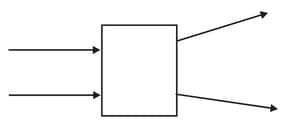Two convex lenses A and B of focal lengths and respectively are placed coaxially distance apart. A point object is kept at a distance of in front of lens A. Find the value of so that the rays emerging from lens B are parallel to its principal axis.
Important Questions on Light – Reflection and Refraction
The following diagram shows the use of an optical device to perform an experiment of light.

As per the arrangement shown, the optical device is likely to be a _____.
A converging lens forms a three times magnified image of an object, which can be taken on a screen. If the focal length of the lens is , then the distance of the object from the lens is _____.
A student wants to obtain magnified image of an object AB as on a screen. Which one of the following arrangements shows the correct position of AB for him/her to be successful?
If a lens can converge the sun rays at a point away from its optical centre, the power of this lens is _____.
An object is placed at a distance in front of a convex lens of focal length .
(i) Calculate the distance of the image from the lens.
(ii) Calculate the magnification of the image.
A virtual, diminished image is formed when an object is placed between the optical centre and the principal focus of a lens.
(i) Name the type of lens which forms the above image.
(ii) Draw a ray diagram to show the formation of the image with the above stated characteristics.
Analyse the following observations table showing variation of image distance () with object distance () in case of a convex lens and answer the questions that follow, without doing any calculations:
| S.No. | Object distance u(cm) |
Image distance v(cm) |
(a) What is the focal length of the convex lens? Give reason in support of your answer.
(b) Write the serial number of that observation which is not correct. How did you arrive at this conclusion?
(c) Take an appropriate scale to draw ray diagram for the observation at S.No. and find the approximate value of magnification.
Each lens has a point, a ray passing through it goes without deviation. What is the name of that point and where is it located?

